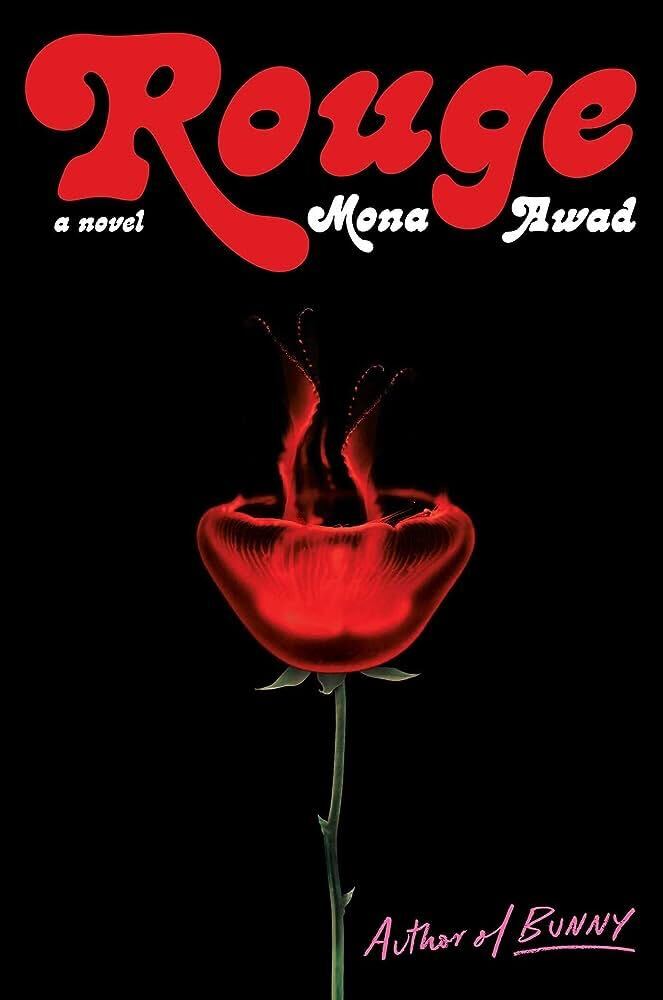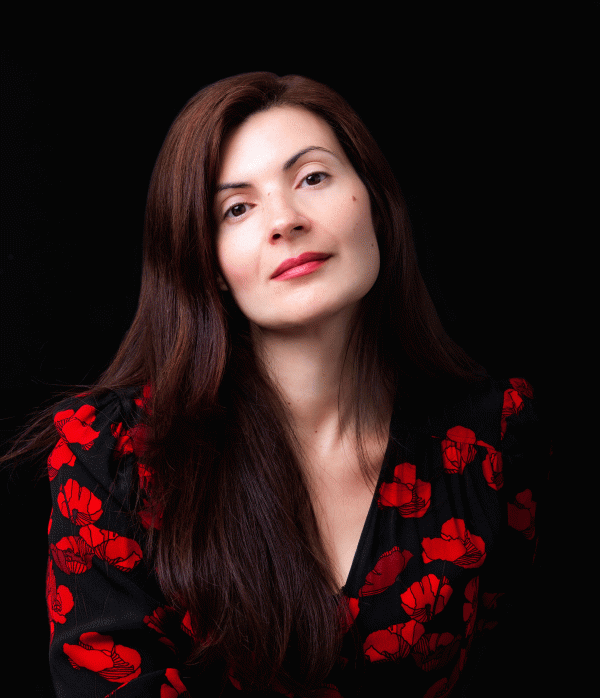Rouge, the most recent novel by Bunny author Mona Awad, is nothing if not surreal. Luckily, it’s in the hands of an author who excels at the unworldly. Tokened as a “horror-tinted gothic fairy tale” and “Snow White meets Eyes Wide Shut,” Rouge follows Belle, a skincare-obsessed dress store clerk reeling from the sudden death of her estranged mother when she unwillingly finds herself on a mystical journey in search of hidden beauty and lost youth. Belle soon becomes enmeshed in the highly secretive organization known only as “Rouge” — a cult masquerading as a part-time spa — that sucked her mother into its orbit in her final days. Awad’s fourth novel, Rouge sees the author blend the strongest elements of her earlier work — the adolescent tenderness of 13 Ways of Looking at a Fat Girl, the desperation of All’s Well, and Bunny’s cult antics — and leaves readers with perhaps her most impressive effort yet.
If Rouge is not compelling enough as told by Belle, a grieving, obsessive, devastatingly lonely 38-year-old woman, Awad incorporates a more vulnerable take on the character in the form of tender, blurry, and mostly repressed memories of Belle at age ten. In a clever move that adds to Rouge’s intrigue, Awad disrupts the now-adult Belle’s linear narrative with occasional interludes from ten-year-old Belle (notably, an age from which adult Belle has no memories.) With uncynical earnestness, Awad uses these interludes to slowly build toward a pivotal event the adult Belle has all but erased. The grown-up Belle is far removed from — and paralyzed inside of — this ten-year-old version of herself. She may be estranged from her childhood memories, but she finds her life shaped by the same unchanging dynamics, particularly the one between herself and her mother, Noelle. At ten, Belle longs to be grown up, to be both like her mother — fiercely independent, adored by men and the world around her, unquestionably beautiful — and at the same time, far, far away from her. At 38, she is scarred, mentally and physically, by their dynamic, yet resentful of their distance.
It is in this tender, often contradictory, and sometimes indecipherable mother-daughter relationship where Rouge truly hits its stride. Awad navigates the frustrating and, at times, heartbreaking nuances of their dynamic with compassion and expert wit, and shines especially in her depiction of Belle’s experience as a mixed-race child raised by a white, beauty-obsessed mother. Belle’s self-image is shaped by her mother, and even more so by this unchangeable difference. It is through this lens that each of her mother’s myriad resentments become refracted, and it’s the same lens through which Belle develops her stubborn obsession with beauty. “I’m ethnic, aren’t I?” thinks Belle early in the novel, during a tense moment at Noelle’s funeral. “Something other than Mother, anyway.”
As young Belle moves through the world, always on the periphery of her mother’s whiteness, she has no choice but to internalize this difference. Belle and Noelle’s relationship, tortured on so many layers, is particularly strained along its ethnic lines; “something other than Mother” becomes the nexus of Belle’s sense of self. Noelle praises Belle’s Egyptian features in the same breath that she laments the ugliness of her own mild tan. Even as a child, Belle sees her mother’s flattery as just placation — there is some fundamental ugliness present in her that her always-beautiful mother cannot unmake, and that she can’t help but occasionally prey on. These layers of resentment — the pivotal, unchangeable difference between mother and daughter, is a stubborn wedge that survives the length of their relationship, making itself known again and again in increasingly devastating revelations. In one critical moment, while admiring her reflection after an ostensibly horrific skincare procedure, Belle privately muses, “There is a whiteness, isn’t there?”
Existing parallel to Belle’s complex relationship with her mother is her almost compulsive obsession with skin, which Awad cleverly uses as a bridge from the real world into her carefully constructed brand of satirical fantasy. Long before we come to understand the intricacies of Belle’s backstory, she’s introduced through her elaborate, rigid skincare routines, which Awad describes with almost scientific precision. During each of these multiple daily rituals, Belle carefully recites the full name and supposed benefit of each in the seemingly infinite process while at the same time emphasizing the pain — a constant, almost unbearable burning sensation — that comes with applying each layer. Her simultaneous dedication to preserving beauty and her willingness to disregard pain, while hardly a new phenomenon, make her obsession all the more intriguing.
Indeed, with each layer of product, the line between self-improvement and self-destruction grows perpetually more blurry. Belle, though held in her own regard as an expert in skincare, bucks the medical wisdom and common sense that would suggest a constant burning may signal a product isn’t working correctly, and instead wears the pain like a badge of honor. When particularly stressed, we see her go so far as to perform routines — triple-cleansing, for one — that, while they may appear effective at first glance, do more to damage than preserve her all-too-precious skin. Belle even seems to recognize this pattern of destructive beauty obsession when it manifests in others, at one point describing another woman’s skin as having “that preserved, almost picked quality, suggesting a complex system, a rigid methodology that might be failing her.” Still, she returns home to readily apply an acid that burns her face, carefully eroding the distance between her imperfect skin and the unattainable quality of her mother’s. Here, Awad leaves the meaning of Belle’s obsession enticingly ambiguous; perhaps a form of self-harm by a woman in perpetual crisis, perhaps a last grasp at connecting with a beauty-obsessed, otherwise-estranged mother — or, perhaps, a means of becoming her mother in some way, metaphorically or even physically. Still, ever dedicated to the novel’s fairytale inspirations, Awad doesn’t let this obsession pass without a moral — it’s Belle’s unrelenting desire for perfect skin, after all, that leads her straight into the belly of Rouge’s cultic beast.
Here, it would be remiss to discuss the dark fantasy at the center of Rouge without giving proper credit to Awad’s sense for satire. In a novel following two ostensibly tragic figures — a distant mother fated to meet her brutal end and a daughter plagued by grief, drowning in her attempts to navigate an adult life — Awad’s signature tongue-in-cheek outlandishness, though hidden at first, makes itself known in spades. Reminiscent of Eyes Wide Shut, The Stepford Wives, and wealthy, nefarious, real-life secret organizations of yore (the Church of Scientology comes to mind), Awad has perfected the craft of writing a cult that is entertaining in its ridiculousness without undermining its horror. Though it’s difficult to explain without spoiling the entire novel, Awad complicates Rouge with a twist that’s equal parts surprising, supernatural, and hilarious, and somehow saves the story from becoming overwhelmingly bleak while, at the same time, making it all the more tragic. (Admittedly, the pivotal, fantastical reveal in Rouge may be slightly less deftly navigated than that of Bunny, but is no less entertaining).
Cementing Rouge’s ability to be fantastical and even funny without discounting the tragedy of its core is the novel’s gradual transition from the real to the magical, aided by Awad’s expertly constructed narration. While the novel’s early sections are marked by Belle’s sharp, witty internal monologue, we see this train of thought rapidly devolve into an all-encompassing, trance-like brain fog as her life becomes increasingly surreal. Just as we start to become accustomed to Belle’s bleak and blunt way of rationalizing her grief, the Belle we’ve come to know disappears. As she finds herself increasingly entangled within the cult’s web, Belle’s critical thinking turns to sludge — her mysterious “treatments” suddenly become the only subject of her attention. She mixes up words — “dress” becomes “dread,” “skin” becomes “sin” — and fails to recognize familiar faces, even going as far as to forget the steps to her beloved skincare routine before forgoing it altogether. Her grip on reality and time, two elements already blurred by her grief, seems to slip entirely. While this turn could easily become unnavigable under a less careful author, Awad manages to bring us in and out of Belle’s trance, from blurry repressed memory into illogical present with ease — and without sacrificing the novel’s heart-pounding pace or thrilling mystery. Instead, Rouge’s reality becomes increasingly surreal without ever seeming to jump the shark.
Rouge’s dialogue may be the one area where the novel occasionally starts to falter, but, typical of a Mona Awad novel, it’s not without its own levels of intrigue. Instead, in a pattern not isolated to this novel, Awad seems to perform a literary bait-and-switch with her dialogue, which at first reads as off-puttingly disingenuous before revealing itself as a secret plot device of its own. In Rouge, this pattern appears during Belle’s conversations with her mother, where the inconsistency of their interactions can be read as intentionally warped to the point of disbelief through the lens of Belle’s perspective. In the foggy, surreal memories of ten-year-old Belle, Noelle’s words toward her daughter feel detached at best, envious, and even hateful at worst. Then, during adult Belle’s even more surreal conversations with her mother’s spirit, the ghostly Noelle is warm, affectionate, and even remorseful in a way that seems to betray the very essence of her daughter’s memories. In an instant, the mother best described as “distant” becomes a figure ashamedly aware of her wrongdoings, ready with an arsenal of apologies, self-awareness, and — in a first — maternal instinct, before Belle can utter a word. The two Noelles seem irreconcilable, and sometimes almost one-dimensional as a result; then again, Awad leaves open the possibility that neither version is entirely real. Instead, the Noelles we see are perhaps both just partial versions, refracted through the eyes of her daughter, to whom making sense of their relationship seems as insurmountable as bringing down the cult itself. Too late to repent on her own, she is doomed to serve as both the white knight of Rouge’s gothic fairy tale, and at other times, as an almost cartoonish evil queen.
Rouge is exciting, not just because of its engaging premise, but because it truly feels like the culmination of everything Awad has been building towards in her body of work. For fans of the author’s past tragic protagonists, supernatural interventions, and biting wit, it promises not to disappoint. The inheritor of its predecessors’ strongest traits, in Rouge, Awad’s humor, outlandishness, and vulnerability are at their peak.
Images via Simon & Schuster

